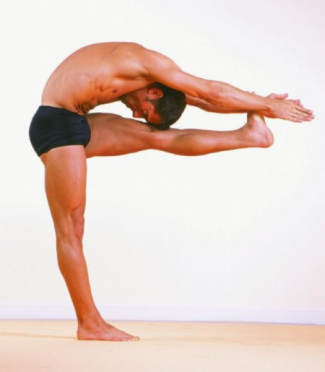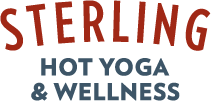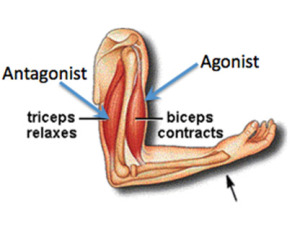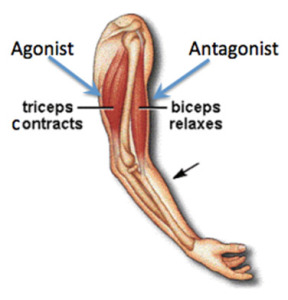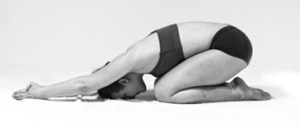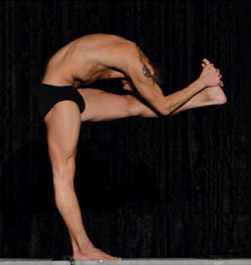
Engage your abs in the balancing series poses. Your core strength helps with both balance and alignment.
When people first start to practice and hear teachers tell yogis to lock their knee, a variety of thoughts pop into their head:
“No way! My coach told me to always keep the knees bent!”
“No way! My drill sergeant (or choral teacher or minister) told me I’d pass out if I locked my knees!”
“No way! That will hurt!”
“Okay”
Every one of these answers is a legitimate response. The key to locking your knee is knowing HOW to lock your knees and how to NOT lock your knees. There’s a big difference.
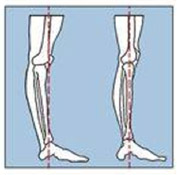
A properly locked knee maintains the natural alignment of the leg (right).
When you hyperextend your knee, the weight of your body is on the heel of the foot and the knee joint is pushed beyond the natural alignment of the leg (see image to the left).
Obviously, the leg on the left is positioned beyond where it should be; the leg on the right is in better alignment.
Let’s further examine each of the poses in the balancing series to discuss the best way to achieve proper knee alignment in each. (Hint: There’s one pose in the balancing series that’s easier than the rest to maintain a locked knee!)
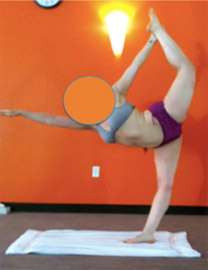
A hyperextended knee puts more weight on the heel and takes the knee out of proper alignment.
Compare these two Standing Bow images:
Initially the image to the right looks like a fairly impressive standing bow. But upon closer inspection, you can see that this yogi’s standing leg is hyperextended—she is out of alignment.
Over time, this leads to over stretching, tearing of ligaments and tendons, and grinding of bone. In fact, this person, after years of holding the pose like this, suffered a torn meniscus in one of her knees!
Take a look at the image on the bottom right. Can you see the difference?
Can you see how this yogi’s standing leg is strong and her quadriceps and inner thigh are engaged?
Can you see how the weight on her foot is equally distributed and she is not leaning too far back into the heel or to the outside of the foot? This is the locked knee you are striving for!
It’s easiest to hyperextend the knee in Standing Head to Knee and Standing Bow because it takes strength to create the counterbalance necessary to stay in alignment.
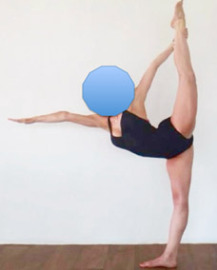
A properly locked knee in Standing Bow depends on even weight distribution in the foot and a strong kick up.
In Standing Head to Knee, be mindful of the weight on your heel. When you grab your foot and start the pose, think UP and immediately contract your quads and engage your inner thighs to keep your leg in alignment. This will take practice.
Then when you kick out, be mindful of the weight on your heel and in the back of your knee. If you feel your weight dropping back, kick forward more! The action of kicking forward in combination with a strong standing leg will keep you in alignment.
And keep your stomach sucked in! See how the abdominal muscles are engaged in the photo at the top of the page? Your core strength will help with balance and alignment!
In Standing Bow, again it’s all about the strength of the standing leg, but it’s also about kicking and stretching—they are equal and simultaneous, 50-50—ever hear that before?
By really reaching forward with the extending arm and kicking with your lifted leg, you will keep the weight in your standing leg more evenly distributed. It all works together!
The Balancing Stick posture is the easiest of the three balancing poses to keep your leg in alignment—why? Because your standing leg is like the fulcrum of a teeter totter—the weight is, more or less, more equally distributed across the plane of your body.
But that doesn’t mean you can relax in this posture—keep your leg engaged and keep stretching forward and backward—stretch, stretch stretch!
None of this is easy. It takes a lot of practice and just when it seems you’ve got it down, your leg will relax, you’ll lose your hard-earned balance, or something will happen and you’ll fall out. Not to worry, just keep trying.
And if you want to see what your balancing legs look like—let our teachers know—they are happy to take some time before or after class get your photo while you’re in the postures!
Remember the key is to Lock the Knee AND Stay in Alignment!
